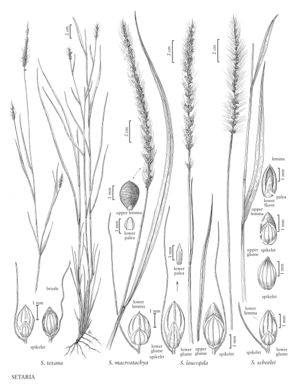Difference between revisions of "Setaria texana"
FNA>Volume Importer |
imported>Volume Importer |
||
| (7 intermediate revisions by 2 users not shown) | |||
| Line 26: | Line 26: | ||
-->{{#Taxon: | -->{{#Taxon: | ||
name=Setaria texana | name=Setaria texana | ||
| − | |||
|authority=Emery | |authority=Emery | ||
|rank=species | |rank=species | ||
| Line 33: | Line 32: | ||
|basionyms= | |basionyms= | ||
|family=Poaceae | |family=Poaceae | ||
| + | |illustrator=Linda A. Vorobik;Annaliese Miller | ||
| + | |illustration copyright=Utah State University | ||
|distribution=Tex. | |distribution=Tex. | ||
|reference=None | |reference=None | ||
| Line 38: | Line 39: | ||
|publication year= | |publication year= | ||
|special status= | |special status= | ||
| − | |source xml=https:// | + | |source xml=https://bitbucket.org/aafc-mbb/fna-data-curation/src/200273ad09963decb8fc72550212de541d86569d/coarse_grained_fna_xml/V25/V25_1401.xml |
|subfamily=Poaceae subfam. Panicoideae | |subfamily=Poaceae subfam. Panicoideae | ||
|tribe=Poaceae tribe Paniceae | |tribe=Poaceae tribe Paniceae | ||
Latest revision as of 18:56, 11 May 2021
Plants perennial. Culms 30-70 cm, wiry, much branched distally. Sheaths keeled, margins ciliate distally; collars glabrate; ligules to 1 mm, densely ciliate; blades 5-15 cm long, 2-4 mm wide, flat, scabrous. Panicles 2-6 cm, spikelike, basal portion rarely lobed, tapering distally; rachises scabrous to puberulent; bristles solitary, 3-10 mm. Spikelets 1.9-2.1 mm. Lower glumes about 1/2 as long as the spikelets, 3-veined; upper glumes about 3/4 as long as the spikelets, 5-veined; lower lemmas nearly equaling the upper lemmas, 5-veined; lower paleas rudimentary to 1/2 as long as the upper paleas; upper lemmas finely and transversely rugose; upper paleas narrow. 2n = 36.
Discussion
Setaria texana grows in shaded habitats on sandy loam soils of the Rio Grande plain of south Texas and northeastern Mexico.
Selected References
None.
